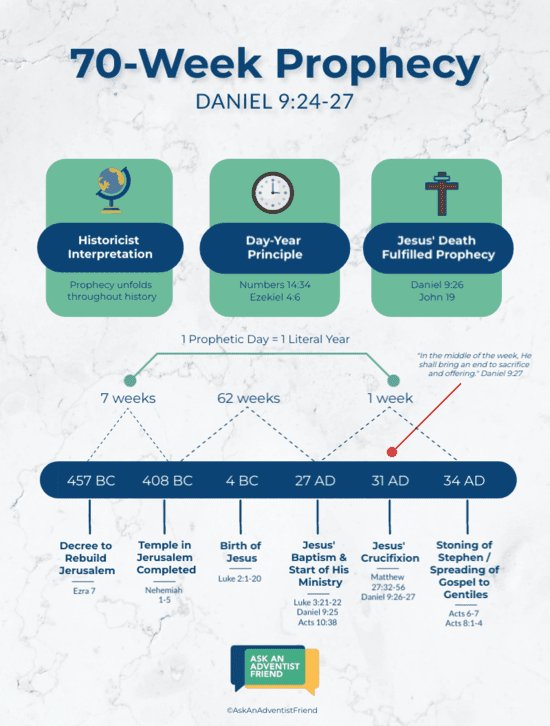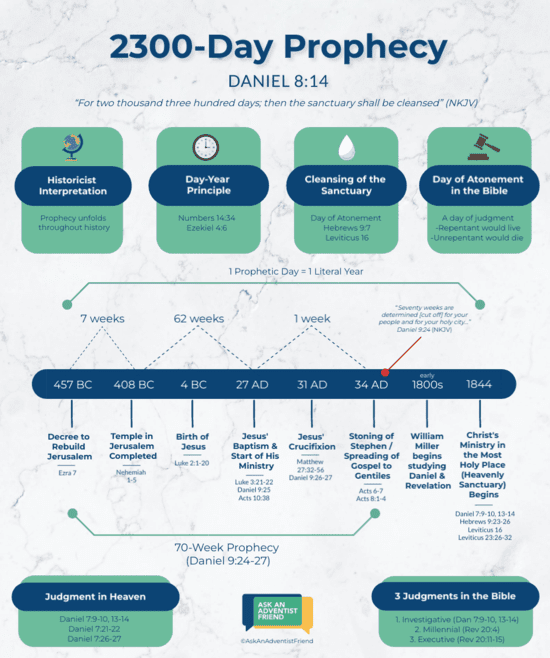Could a prophecy accurately predict an event over 500 years before it was supposed to happen?
The 70-week prophecy of Daniel 9 did, culminating in one of the most important events in earth’s history: Jesus’ sacrifice for us on the cross. This prophecy, spanning 490 years of time, indicated when Jesus would begin His ministry and when He would die. It gave God’s people hope that He hadn’t forgotten them and was going to provide the ultimate solution to their sins.
That solution reaches down to us. And though the 70-week prophecy is now past, it gives us confidence in the Bible and its predictions.
It also helps unlock an important prophecy related to the end times of this earth’s history.
In this article, we’ll unpack:
- How Adventists interpret the 70-week prophecy
- Events that fulfill the prophecy
- How the prophecy relates to the end times
Let’s start with an overview of the 70 weeks before getting a closer look.
How Adventists interpret the 70-week prophecy
 The 70-week prophecy is a messianic prophecy given to Daniel that covers a span of 490 literal years. It began with the decree to rebuild the Old Testament city of Jerusalem and ended in the New Testament with the spreading of the gospel among the Gentiles, or non-Jews.
The 70-week prophecy is a messianic prophecy given to Daniel that covers a span of 490 literal years. It began with the decree to rebuild the Old Testament city of Jerusalem and ended in the New Testament with the spreading of the gospel among the Gentiles, or non-Jews.
You can find the prophecy in Daniel 9:24–27. It contains important predictions about Jesus, who would be sacrificed on the cross for our sins.
Adventists interpret the 70 weeks using the historicist framework of interpretation. According to Adventist theologian Gerhard Pfandl, this framework sees Bible prophecy as unfolding throughout history—rather than being far in the past or far in the future.1
Historicists believe that the prophecies of the book of Daniel cover the time from the sixth century B.C. (when the book was written) down to the end of the world.
And this approach is consistent with the way Daniel himself understood the prophecies he received.
For example, Daniel 8 records a vision that Daniel had during the reign of the Babylonian king Belshazzar. In the vision, Daniel saw a goat and a ram, representing two kingdoms that came one after another.
In fact, an angel came and explained the meaning: “The ram which you saw, having the two horns—they are the kings of Media and Persia. And the male goat is the kingdom of Greece” (Daniel 8:20–21, NKJV).
Medo-Persia and Greece were the two empires that followed Babylon. Thus, the prophecy was unfolding in history, consistent with the historicist viewpoint.
But back to the 70 weeks. You may be asking, how can 70 weeks possibly equate to 490 years?
How long does the prophecy last?
The 70-week prophecy lasts for 490 literal years because of a biblical interpretive concept known as the day-year principle. In Bible prophecy, a day represents a full year of actual time. Many scholars agree with this idea.2
The Bible itself gives evidence for this principle too.
For example, when the Israelites disobeyed God, they experienced the consequence of having to wander in the wilderness for 40 years, one year for each day that the Israelite spies had been checking out the promised land. Numbers 14:34 puts it this way:
“According to the number of the days in which you spied out the land, forty days, for each day you shall bear your guilt one year, namely forty years” (NKJV).
The prophetic book of Ezekiel 4:6 also shows this principle in an acted parable that the prophet Ezekiel was asked to perform. Each day that he did so represented a year:
“For I assign to you a number of days, 390 days, equal to the number of the years of their punishment. So long shall you bear the punishment of the house of Israel. And when you have completed these, you shall lie down a second time, but on your right side, and bear the punishment of the house of Judah. Forty days I assign you, a day for each year” (ESV).
Similarly then, 70 weeks, equivalent to 490 days, represents 490 literal years.
When did the prophecy begin and end?
The 70 weeks began “from the going forth of the command to restore and build Jerusalem” (Daniel 9:25, NKJV). As we’ll see later on, the Persian king Artaxerxes’ decree to rebuild Jerusalem was issued in 457 B.C., which means that the prophecy began at this time.
Fast-forwarding 490 years from 457, we arrive at A.D. 34.
Now, if you were doing that math in your head, you might think we should’ve ended up at A.D. 33. However, since there isn’t a year 0, we have to add a year to our calculations. That puts us at A.D. 34.
By now, you’re probably wondering what important events happened within this time.
Events that fulfill the 70-week prophecy
Several significant events happened within the 70 weeks of Daniel 9. They are:
- The decree to rebuild Jerusalem
- Jesus’ baptism and the start of His ministry
- Jesus’ crucifixion
- The stoning of Stephen and the gospel going more fully to the world
Within Daniel’s prophecy, you may have noticed the 70 weeks are divided up into three sections: seven weeks, 62 weeks, and then one last week. These all have significance, as we’ll explore next.
The decree to rebuild Jerusalem
 The first seven weeks, Daniel says, were allotted for the building of Jerusalem:
The first seven weeks, Daniel says, were allotted for the building of Jerusalem:
“Know therefore and understand, that from the going forth of the command to restore and build Jerusalem until Messiah the Prince, there shall be seven weeks and sixty-two weeks; the street shall be built again, and the wall, even in troublesome times” (Daniel 9:25, NKJV).
The Israelites, or Jews, had been in captivity in Babylon for years. Finally, Cyrus, the king of Persia, made the decree in 538 or 537 B.C. for the temple to be rebuilt, meaning the Jews were freed and allowed to return to their homeland (Ezra 1).3
Then, Darius I, a king after Cyrus, made a second decree that ensured the temple was finished. His decree was longer than Cyrus’s initial decree and included far more detail (Ezra 6).
The temple was finished in 516 B.C.
But Jerusalem was still in ruins; the prophecy could not yet begin.
Years passed, and another Persian king ascended the throne: Artaxerxes. He commanded Ezra, a Jewish priest, to reinstate the local Jewish government. This decree was much longer than any of the previous decrees and contained even more detail (Ezra 7:12–26).
The date for this decree was 457 B.C., and it brought about the full restoration of Jerusalem. According to Ezra 7, this decree took place in the seventh year of Artaxerxes’ reign.
But how do we know the seventh year of his reign was 457 B.C.?
Some scholars debate this date because different nations had their own calendars—all of them different from the calendar we use today. However, four different documents help prove the validity of this date.
An Adventist scholar and archeologist, Siegfried H. Horn, notes how these documents do just that:4
- Ptolemy’s canon. This is a list of kings stretching from the 8th century B.C. to the second century A.D. In it, we can find the dates of Artaxerxes’ reign.
- The Jewish calendar. Depending on where the Jews lived, they used different methods for dating their calendars. Ezra and Nehemiah used the fall-to-fall calendar.
- Aramaic papyrus from Elephantine. This papyrus included a date in the Egyptian calendar that corresponded with the Jewish calendar—something that was only possible if the Jewish calendar was a fall-to-fall calendar. This showed that Ezra and Nehemiah used the fall-to-fall calendar, helping to further establish the date of 457 B.C.
- The tablet from Ur. This tablet clearly shows the year of King Xerxes’ death, which is necessary to know when King Artaxerxes came to the throne.
Following the start of Daniel’s prophecy, the first seven weeks—49 literal years—were allotted for the rebuilding of Jerusalem. And 49 years later, in 408 B.C., the city was finished (Nehemiah 1–5).
Jesus’ baptism
The next 62 weeks represent the period of time between the Old Testament and the New Testament. The end of the 69th week (seven weeks for the rebuilding of Jerusalem and 62 after) brings us to A.D. 27. At this point, Daniel said the Messiah would come (Daniel 9:25).
Naturally, the Messiah was on the tongue of every Jew who hoped He would come and save them from their oppressors. Throughout the Old Testament Scriptures,5 God had indeed promised a Messiah, and Daniel 9 reiterates that promise.
Daniel 9:24 states that one of the purposes of the 70 weeks was “to anoint the Most Holy” (NKJV).
The next verse says that the 69 weeks would stretch from the decree to rebuild Jerusalem to “Messiah the Prince” (Daniel 9:25, NKJV).
Interestingly, both the Hebrew and Greek words for Messiah mean “the anointed one.”
When was Jesus anointed?
At His baptism in A.D. 27 (Luke 3:22). This event, at which the Holy Spirit came upon Jesus in the form of a dove, marked the beginning of His ministry.
The apostle Paul also recognized this event as Jesus’ anointing when he said in Acts 10:38:
“How God anointed Jesus of Nazareth with the Holy Spirit and with power, who went about doing good and healing all who were oppressed by the devil, for God was with Him” (NKJV).
Jesus was about 30 at His baptism in A.D. 27 (Luke 3:23). Thus, His birth would have been in 4 B.C. (remember, there is no year 0). This date lines up with the reign of Herod the Great (37–4 B.C.), who was the king at the time of Jesus’ birth (Matthew 2).6
Jesus’ crucifixion
The next event in the 70-week prophecy is Jesus’ crucifixion, which took place after His three-and-a-half-year ministry in the spring of A.D. 31.
This coincides exactly with what the prophecy foretold. Daniel 9:26 (NKJV) says, “And after the sixty-two weeks Messiah shall be cut off, but not for Himself.”
Verse 27 adds, “Then He [the Messiah] shall confirm a covenant with many for one week; but in the middle of the week He shall bring an end to sacrifice and offering” (NKJV).
During the last seven years of the 70-week prophecy, Jesus was confirming the covenant—the faithful promise God had made repeatedly throughout the Old Testament that He would provide salvation for His people (Genesis 3:15; 15:1–18; Isaiah 54:10).
And as Daniel 9:26–27 points out, Jesus was to be “cut off,” and “in the middle of the week He shall bring an end to sacrifice and offering.”
The middle of the week of seven years was three and a half years—precisely when Jesus died. His crucifixion was His cutting off.
Isaiah 53:8, a passage of Scripture that foretold Jesus’ suffering, uses similar wording:
“He was cut off from the land of the living; He was struck because of my people’s rebellion” (CSB).
But why the term “cut off”?
It has its roots in an ancient practice of solidifying a contract, called “cutting a covenant.”
In the ritual, an animal was cut in two, and the individuals making the covenant with each other would pass between the pieces.
A little gruesome?
Yes, but this ritual had deep significance.
Ty Gibson, a Seventh-day Adventist author and speaker, writes,
“The ritual of cutting an animal in two and walking between the severed pieces communicated that a person was pledging their very life to fulfill their promise.”
And God Himself made a covenant like this with Abraham and all the generations to follow (Genesis 15).
But there’s more—God didn’t just hold up His end of the deal. He chose to be cut off to hold up our end. He was faithful on our behalf!
All of that is hinted at in the 70-week prophecy.
Jesus’ death fulfilled other elements of it as well. Daniel 9:24 says the 70 weeks would:
- Make an end of sins. Jesus didn’t die to pardon Himself; He died for us and our countless sins. Daniel 9:26 alludes to this when it says Jesus was “cut off, but not for Himself.” And the even greater news is that His death has provided for the ultimate triumph over sin so that someday it will be completely eradicated from our world (John 1:29).
- Bring an end to sacrifice and offering. The moment Jesus died, the curtain in the Jewish temple was torn from top to bottom (Matthew 27:51). This was overwhelmingly significant because, for centuries, the Jews had sacrificed animals to God in the temple as a symbol of receiving pardon for their sins. It was a physical reminder of what Jesus would do on the cross. He was the ultimate sacrifice for every person’s sin, putting an end to the sacrificial system of the temple (Hebrews 9:11–15; 10:12).
- Seal up vision and prophecy. The 70 weeks are a continuation of a prophecy that an angel presented to Daniel in chapter 8: the 2300 days. Just like a seal guarantees the authenticity of a document, the 70-week prophecy helps guarantee the authenticity of the 2300-day prophecy and establish its timeline and later fulfillment.7 We’ll look at this more in a later section.
The stoning of Stephen and the gospel going more fully to the world

Photo by Astrid Schaffner on Unsplash
Daniel doesn’t mention anything specific happening at the end of the 70-week prophecy, but from historical evidence, we can gather that after three and a half years, two things occurred: a Christian leader by the name of Stephen was martyred, and the gospel went more fully to the non-Jewish world.
Stephen was an early Christian and a powerful speaker who garnered attention because he was preaching about Jesus Christ and performing miracles. The Jewish leaders wanted to stop his work, so they falsely accused him and stoned him to death (Acts 6–7).
Christians often refer to him as the first Christian martyr.
With Stephen’s death, persecution against the early Christians increased, and many of them fled Jerusalem. In doing so, they carried the gospel farther, especially to non-Jews (Acts 8:1–4).
All throughout the Old Testament, the Jewish nation had been God’s special people (Deuteronomy 14:2), but they had struggled to remain faithful to Him. The purpose of the 490 years of the 70-week prophecy was to give them an opportunity to return to God (“seventy weeks are determined for your people”) and receive the Messiah. Instead, the leaders of the Jewish nation rejected Jesus and gave up their special position. They confirmed this decision in their stoning of Stephen.
This being said, every individual Jew still has the opportunity to be part of God’s family.
But now, everyone who loves and accepts Christ forms that special nation (1 Peter 2:9).
The destruction of Jerusalem
The 70-week prophecy also mentions an event that occurred after the close of the prophetic time. This was the destruction of Jerusalem, and particularly, the temple.
Daniel 9:26 says,
“And the people of the prince who is to come shall destroy the city and the sanctuary” (NKJV).
The Jewish-Roman War lasted from A.D. 66–73. Its most decisive event occurred in A.D. 70 when the future Roman emperor Titus destroyed Jerusalem and the temple.8
With the utter destruction of Jerusalem, all the surviving Jewish people fled. They scattered permanently throughout Asia, Africa, and Europe. This also ended the physical temple sacrifices that the Jews who didn’t believe in Jesus continued making.
And with that, we come to the end of our overview of the 70 weeks.
But a question remains: If the time period ended within the first century, what is its significance to us today?
You may remember we mentioned that the 70 weeks form part of a larger prophecy. Let’s see how they connect to each other and relate to the times we’re living in.
How the 70 weeks relate to the end times
 The 70 weeks of Daniel 9 are tied to the 2,300 days mentioned in Daniel 8—a prophecy that comes right down to our time. Through learning about both of them, we can better understand what Jesus is doing in heaven to prepare His people for the Second Coming.
The 70 weeks of Daniel 9 are tied to the 2,300 days mentioned in Daniel 8—a prophecy that comes right down to our time. Through learning about both of them, we can better understand what Jesus is doing in heaven to prepare His people for the Second Coming.
Daniel received the vision about the 2,300 days when he was in Babylon. In the vision, the angel Gabriel told Daniel:
“For two thousand three hundred days; then the sanctuary shall be cleansed” (Daniel 8:14, NKJV).
The 2,300 days represent 2,300 literal years. When they would come to an end, something called “the cleansing of the sanctuary” would take place.
But what is the cleansing of the sanctuary?
This phrase refers to a special work of judgment that Jesus would perform in the heavenly sanctuary, foreshadowed by the Day of Atonement ceremony of the Israelites. It was the final step in completely cleansing the Israelite camp and sanctuary from sin.
Just as the high priest in Israel would once a year go into the Most Holy Place compartment of the sanctuary and symbolically cleanse all the sins, so Jesus would enter once and for all into the Most Holy Place of the heavenly sanctuary. There, He would cleanse the records of heaven and blot out all the sins of those who have accepted His gift of salvation.9
According to the timeline of Daniel, this judgment takes place right before Jesus’ return (Daniel 7:9–10; 13–14).
But we can pinpoint an even clearer date when we realize that the 2,300 years began at the same time as the 70-week prophecy.
How do we know?
After seeing the vision about the 2,300 days, Daniel was disturbed and wanted to understand what it meant (Daniel 8:27).
He prayed earnestly for answers, but those answers would not come for a while. Finally, the next chapter shows Daniel praying when the angel Gabriel visits him again.
Gabriel tells him, “Consider the matter and understand the vision” (Daniel 9:23, NKJV). No other vision has been mentioned between Daniel 8 and Daniel 9, so he must have been referring to the 2,300 days.
And there’s more:
When Gabriel begins to tell Daniel the 70-week prophecy, he says, “Seventy weeks are determined” (Daniel 9:24, NKJV).
The word for determined means “cut off” in Hebrew.
Read that way, Daniel 9:24 would say, “Seventy weeks are cut off for your people and for your holy city.”
Cut off from what? The most probable answer is the 2,300-day period mentioned in the preceding chapter.
That means that the 2,300 years also began in 457 B.C. And it ended in A.D. 1844.
But there’s another connection.
The 70 weeks foretold Jesus’ role as a sacrifice for our sins, fulfilling the sacrifice of animals in the Old Testament sanctuary.
And the cleansing of the sanctuary that will happen after the 2,300 years will fulfill another aspect of the sanctuary services: Jesus doing a work that will get rid of sin for good.
Ever since the fall of mankind, God has had a plan to restore us to the perfect beings we were created to be. This promise has echoed through the annals of time. Someday, Jesus will come, and all sin will be completely eradicated.
The 70 weeks are an integral part of this promise being kept. They foretold the first coming of Jesus, who would make a way to restore God’s people to perfection. And the 2,300-day prophecy links the 70 weeks to the sanctuary’s cleansing—the final step in getting rid of the sins of God’s people.
The 70 weeks point to the one who put the plan of salvation into action—and will bring it to completion.
Choose an Online Bible Study
Want to keep learning? Find out more about Jesus, humanity, the plan of salvation, and how God loves you enough to sacrifice everything, just to give you a chance to choose Him.
Sometimes it can be hard to know where to start, that’s why we offer free, user-friendly, online Bible study options you can do anytime, anywhere, and at your own pace.
This online Bible school will take you through the major themes of Scripture, breaking down the Bible’s complex concepts into bite-sized pieces, which can lead you toward the answers of life’s more challenging questions.
- Pfandl, Gerhard, “Understanding Biblical Apocalyptic,” Biblical Hermeneutics: An Adventist Approach, p. 273–278.[↵]
- Pfandl, Gerhard, “In Defense of the Year-Day Principle,” Journal of the Adventist Theological Society, 23:1, 2012, pp. 3–17. [↵]
- Tolhurst, L. P., “Establishing the Date 457 B.C.” Ministry, April 1988. [↵]
- Horn, Siegfried H., “Research: the Seventh Year of Artaxerxes I,” Ministry, June 1953. [↵]
- Genesis 3:15; Numbers 24:17–19; Psalm 2:7–9. [↵]
- “Herod” Britannica. [↵]
- Maxwell, Mervyn, God Cares, vol. 1 (Pacific Press Publishing Association, 1981), p. 219. [↵]
- “Jewish-Roman Wars” Heritage-History.com. [↵]
- Hebrews 8:1–3; 9:23–28 [↵]
Related Articles
More Answers
What Does the Bible Say About Debt?
Is it sinful to have debt? Does the Bible provide guidance to the borrowing and lending of money? Let’s take a look.
Should Christians Have End-Time Anxiety?
What goes through your mind when you hear about the “end times?” Do you think of a worldwide crisis that brings out the worst of humanity? Increasing government control? What about scarce resources and being on the run? Surviving the great tribulation?
How Does God Want Me to Use My Money?
The Bible offers lots of wisdom on the best ways we can use our money. Learn what the Bible says about tithe, offering, providing, debt, savings, investing, and budgeting.
What Does the Bible Say About Heaven?
The afterlife is something on all of our minds. Whether Christian or not, human beings have a natural longing to understand what’s next. And nearly every religion has some kind of explanation for it.
What the Bible Says About Money
From stewardship to acts of investment and generosity, let’s explore what the Bible says about having a healthy relationship with our money.
Death
Have you ever wondered about life after death, or what some refer to as the afterlife?
What Does God Look Like According to the Bible?
What Does God Look Like According to the Bible?As human beings, it’s natural for us to wonder about God’s appearance. But the Bible says very little about it. It’s not hard to understand why, though. As the Creator of the entire universe, His existence transcends our...
What Does the Bible Say About Aliens and UFOs?
In 1938, aliens and UFOs were the subject of a mass prank. Around Halloween, Orson Welles performed a radio adaptation of H.G. Wells’ War of the Worlds. This ended up causing a panic throughout the United States—many people took it to mean that aliens had really attacked New Jersey.
Major Fulfilled Bible Prophecies You Should Know About
Prophets seem like something from novels or movies. The predictions they make couldn’t actually happen, could they? After all, nobody can tell the future!
The Seven Churches of Revelation and What They Mean
The seven churches were churches that received messages from Jesus Christ through the apostle John while he was exiled on the island of Patmos. These letters are in chapters 2 and 3 of Revelation.
What Is the Statue in Nebuchadnezzar’s Dream?
Ever had a dream you couldn’t remember? You know it was disturbing, but the details escape you. Ugh, the frustration!
What Are the Three Angels’ Messages in Revelation 14?
The three angels’ messages in Revelation 14 warn the world to worship God, leave religious confusion, and avoid worship of human traditions instead of God’s commands.
The Early Christian Church [Overview]
The Early Christian Church describes the faith community that developed from followers of Jesus after He returned to heaven (Acts 1) in A.D. 31. Their purpose was to be witnesses of the life, death, and resurrection of Jesus and grow their faith community into a worldwide movement.
All About the 2300-Day Prophecy and the Investigative Judgment
This page will explain what the 2300-day prophecy is about. We’ll especially be looking at what events marked its fulfillment and what it has to do with the Investigative Judgment.
What Does the Bible Say About the End Times?
First of all, when we say “end times,” this refers to the period of time that precedes the second coming of Jesus—and the end of this sinful world before it’s recreated into the new earth. And several passages of Scripture provide us with clues and guidelines to help us recognize when these times are near, what kinds of things we can expect, and what it might mean for our daily lives and priorities.
The Creation of the World: What the Bible Really Says
When we think about the biblical Creation story, we think of just that: the world being created by the Creator. And while God’s creation of the world is marvelous and miraculous in its own right, it’s about far more than the sudden appearance of plants, animals, and humans.
Healing in the Bible
Have you ever felt like healing seemed so far away? Like it wouldn’t be possible for you? What you most want is a glimmer of hope or a bit of encouragement.
How Do You Tell a False Prophet From a True Prophet?
The Bible speaks of both true and false prophets and gives us specific guidance on how to test prophets and their claims. Scripture is our guard against deception.
Didn’t find your answer? Ask us!
We understand your concern of having questions but not knowing who to ask—we’ve felt it ourselves. When you’re ready to learn more about Adventists, send us a question! We know a thing or two about Adventists.
















![The Early Christian Church [Overview]](https://cdn-cjldm.nitrocdn.com/gzNqriECCrMztgMvDuvfrBDaorxfXXCV/assets/images/optimized/rev-d0ac9f9/www.askanadventistfriend.com/wp-content/uploads/2023/01/old-temple-400x250.jpg)




